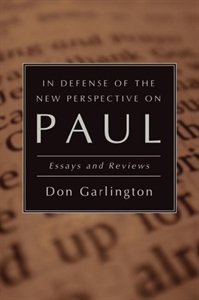In Defense of the New Perspective on Paul: Essays and Review, reviewed by Amos Yong
 Don Garlington, In Defense of the New Perspective on Paul: Essays and Reviews (Eugene, OR: Wipf and Stock, 2005), viii + 245 pages.
Don Garlington, In Defense of the New Perspective on Paul: Essays and Reviews (Eugene, OR: Wipf and Stock, 2005), viii + 245 pages.
Garlington earned his MDiv and ThM degrees from Westminster Theological Seminary (Philadelphia), and his PhD in New Testament at the University of Durham under James D. G. Dunn. He taught from 1987-2002 at Toronto Baptist Seminary, and has served since as an adjunct professor at Tyndale Seminary in Toronto. Previous to this volume, he had authored four others on various aspects of Pauline theology, including book length treatments of the epistles of Romans and Galatians. From the beginning of his academic career, he has been defending a version of what has come to be known as the New Perspective on Paul (NPP).
What is the NPP? The NPP was initially articulated in 1977 by E. P. Sanders in his important book, Paul and Palestinian Judaism, although it was not given this title phrase until Dunn did so in his Manson Memorial Lecture in 1982. In brief, the NPP can be summarized as making three sets of interlocking claims. First, rather than holding to an exclusively defined religion of works-based righteousness, Second Temple Judaism embraced a form of what might be called “covenantal nomism” (Sanders) whereby God established a covenant relationship with his people (in this case, Israel) which required, as a proper response, human obedience to the commandments of the law. Second, that when understood against this background, St. Paul neither advocates a superseding of the law nor offers a polemic against the law as a means of gaining merit; rather he should be read as defending a view of the law as a way of living within and according to the covenant. Finally, then, the Pauline dictum of justification by faith alone is one aspect of a wider covenant that includes rather than excludes the transformed life and the works of faith. Within this scheme of things, one does not “get into” the covenant via keeping the law; instead, one “stays in” the covenant according to one’s faithful obedience to the terms of the covenant (reflected in the law), even if God also graciously provides for the atonement of sins that are inevitably committed by those who fall short because of either faithlessness or disobedience.
What is the New Perspective on Paul?
Category: Biblical Studies, Fall 2007, Pneuma Review


